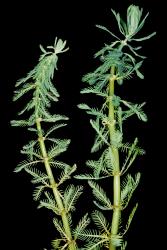- Taxon
- Weed
- Gallery
- ≡ Enydria aquatica Vell.
- = Myriophyllum brasiliense Cambess. (1830)
Stout, glabrous, dioecious herb. Stems to 2 m long, 4–5 mm diam. near base, glaucous, rooting from lower nodes. Lvs all whorled, slightly dimorphic. Submerged lvs in whorls of (4)–5–6, (17)–35–45 × (4)–8–15 mm, oblanceolate or oblong with rounded apex, pectinate; pinnae 25–30, to 7 mm long, linear-subulate. Aerial lvs in whorls of (4)–5–6, (15)–25–35 × (4)–7–8 mm, narrowly oblanceolate or oblong with rounded apex, pectinate, glaucous, ± erect near apex; pinnae (18)–24–36, to 5.5 mm long, linear-subulate, slightly incurved. Base of aerial lvs with numerous hydathodes. Fls solitary in the axils of upper aerial lvs which are almost identical to other aerial lvs. Bracteoles 1.2–1.5 mm long, subulate, sometimes almost 3-fid. ♂ fls not seen in N.Z. ♀ fls with pedicel c. 0.2–0.4 mm long; sepals 0.4–0.5 × 0.3 mm, deltoid, white, denticulate with 1-several teeth; petals 0; ovary 4-ribbed between sepals. Fr. not seen.
[From: Webb et al. (1988) Flora of New Zealand. Volume 4.]
Flowering: Sep.–Feb.




